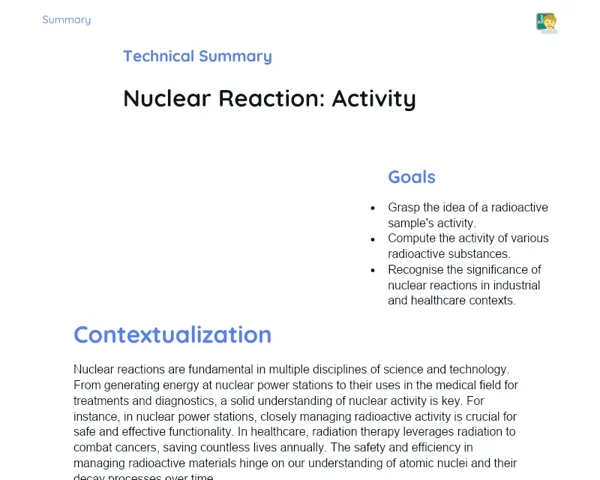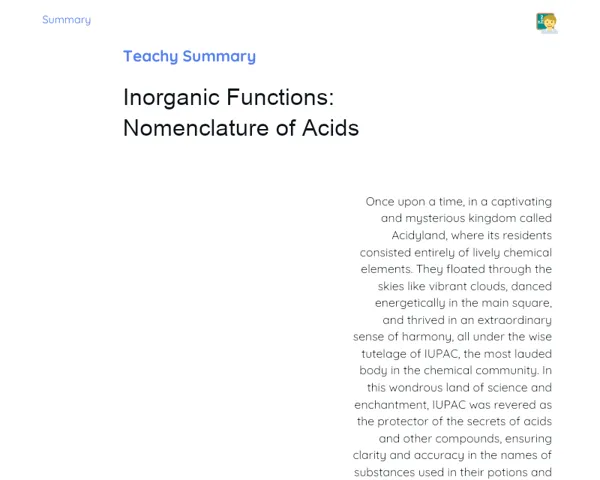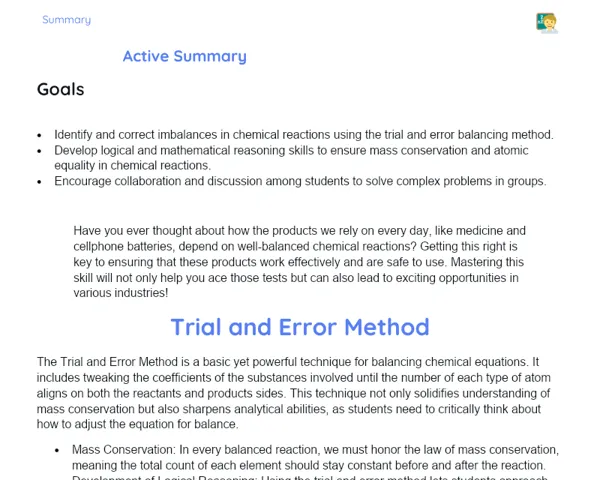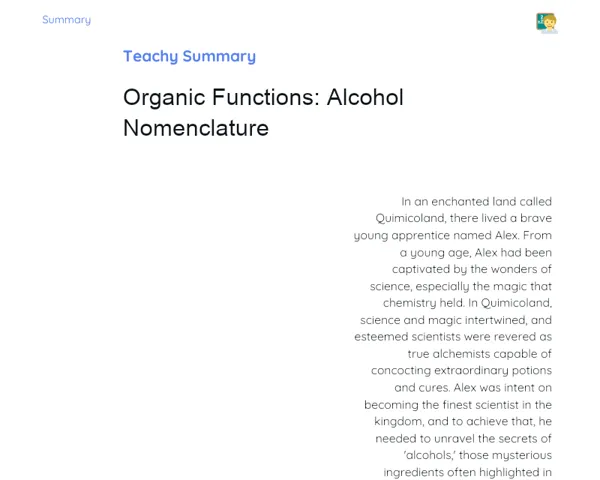Summary Tradisional | Main Physical States of Matter
Contextualization
Matter refers to anything that takes up space and has mass, and it can take on different physical states: solid, liquid, and gas. The state of matter is influenced by how its particles are arranged and their energy levels. In a solid state, the particles are tightly packed and arranged in a structured manner, giving the material a fixed shape and volume. When it comes to liquids, the particles have more freedom to move, allowing the liquid to adapt its shape to the container while keeping a consistent volume. In the gaseous state, particles are spread far apart and move freely, which means the gas doesn't have a defined shape or volume and expands to fill any available space.
Grasping the various physical states of matter is crucial not only for chemistry but also for various other scientific and engineering disciplines. For instance, many industrial processes, such as liquid distillation or the transition of solids to gases (sublimation), rely on these states. Also, everyday occurrences like water evaporating or ice forming are directly linked to these state changes. Hence, understanding the traits and characteristics of solids, liquids, and gases, along with the factors that lead to these transitions, is key to comprehending the environment around us and applying this knowledge practically.
To Remember!
Solid
Solids are characterised by a fixed shape and volume, which occurs because the particles that form a solid are tightly held together, building a rigid and structured framework. The kinetic energy in solids is relatively low, meaning the particles only vibrate around set positions without making significant movement.
This strong attraction between particles makes solids incompressible and generally dense since their particles are quite close together. Everyday examples of solids include ice, iron, wood, and plastic. Each of these maintains its shape and volume regardless of what container they are in.
Moreover, solids can be split into two primary groups: crystalline and amorphous. Crystalline solids have particles that are arranged in a regular and repeating pattern, like salt and diamonds. In contrast, amorphous solids, such as glass and plastic, lack a regular organisation. This distinction in internal structure impacts the physical properties of solids, such as their strength and hardness.
-
Defined shape and volume.
-
Particles tightly bound and structured.
-
High density and incompressible.
-
Can be crystalline or amorphous.
Liquid
Liquids have a set volume, but their shape can vary, adapting to the container they occupy. The particles in a liquid are spaced further apart than in a solid, which allows for greater movement among them due to their higher kinetic energy compared to solids.
Despite having a constant volume, liquids are essentially incompressible, as their particles remain relatively close, albeit not as close as in solids. The density of liquids is generally less than that of solids but still notable. Common liquid examples include water, oil, alcohol, and mercury.
Liquids also display properties like viscosity and surface tension. Viscosity measures how resistant a liquid is to flow, while surface tension relates to the attraction between particles at the liquid's surface. These characteristics are crucial in many practical applications, such as making lubricants and observing how liquids behave in microgravity.
-
Defined volume, variable shape.
-
Particles with greater freedom of movement.
-
Essentially incompressible.
-
Properties such as viscosity and surface tension.
Gas
Gases don’t have a defined shape or volume, as they expand to completely fill their container. The particles in a gas are quite widely spaced and move freely, resulting in a low density and high compressibility. The kinetic energy of gas particles is much higher, allowing them to move quickly and collide with each other and the container's walls.
Thanks to the significant gaps between particles, gases are easily compressed, which is a key trait in numerous industrial applications, such as in the use of gas cylinders. Examples of gases include water vapour, oxygen, carbon dioxide, and nitrogen.
Gases adhere to specific principles, such as the Ideal Gas Law, which connects pressure, volume, and temperature. These principles are fundamental for understanding gas behaviour under various conditions and are applicable in fields ranging from meteorology to chemical engineering.
-
Undefined shape and volume.
-
Particles are spaced apart with high mobility.
-
Low density and easily compressible.
-
Follows specific principles like the Ideal Gas Law.
State Changes
Matter transitions from one state to another due to changes in temperature and pressure. These changes encompass melting (solid to liquid), solidification (liquid to solid), vaporisation (liquid to gas), condensation (gas to liquid), sublimation (solid to gas), and deposition (gas to solid).
Melting occurs when a solid gains enough thermal energy to break its particle bonds and turn into a liquid. Solidification is the opposite process, where a liquid loses energy and the particles regroup into a solid form. Vaporisation can happen either through boiling, when a liquid reaches its boiling point, or evaporation, which takes place at the liquid's surface below that point.
Condensation is when a gas loses thermal energy and changes into a liquid, like the dew formation. Sublimation happens when a solid seamlessly transitions to a gaseous state without becoming a liquid, as seen with dry ice. Conversely, deposition involves a gas turning straight into a solid, such as frost formation.
-
Melting: Solid to liquid.
-
Solidification: Liquid to solid.
-
Vaporisation: Liquid to gas.
-
Condensation: Gas to liquid.
-
Sublimation: Solid to gas.
-
Deposition: Gas to solid.
Key Terms
-
Physical States of Matter: Different forms where matter exists, such as solid, liquid, and gas.
-
Solid: A physical state with a defined shape and volume.
-
Liquid: A physical state with a fixed volume but flexible shape.
-
Gas: A physical state lacking a defined shape or volume.
-
Melting: The state change from solid to liquid.
-
Solidification: The transition from liquid to solid.
-
Vaporisation: The transformation from liquid to gas.
-
Condensation: The transition from gas to liquid.
-
Sublimation: Changing directly from solid to gas.
-
Deposition: Changing directly from gas to solid.
Important Conclusions
The key physical states of matter – solids, liquids, and gases – possess distinct traits that affect their properties and behaviours. Solids maintain a defined shape and volume with closely packed particles, whereas liquids, while having a fixed volume, adapt their shape due to added mobility of the particles. Gases, on the other hand, lack both a defined shape and volume, with particles spread apart and high energy levels, leading to low density and high compressibility.
Transitions in the states, including melting, solidification, vaporisation, condensation, sublimation, and deposition, occur due to changes in temperature and pressure. Understanding these changes is fundamental when interpreting natural phenomena and various industrial processes, such as ice melting, water boiling, and dew forming. Recognition of these processes not only allows for a practical application of knowledge but also furthers comprehension of how matter behaves under varying conditions.
Comprehending the physical states of matter is vital in numerous fields of science and engineering, as well as being practically useful in day-to-day life. Recognising the properties of solids, liquids, and gases, along with the factors triggering state changes, empowers better analysis and practical application of knowledge. I encourage all to delve deeper into this subject to enhance their understanding and ability to apply what they've learned.
Study Tips
-
Review each physical state's concepts and their properties, making comprehensive notes for easier studying.
-
Conduct simple activities at home, like watching ice melt or water evaporate, to see state changes in action.
-
Learn about gas laws and how they operate under various conditions, using tasks and practical examples to strengthen understanding.



